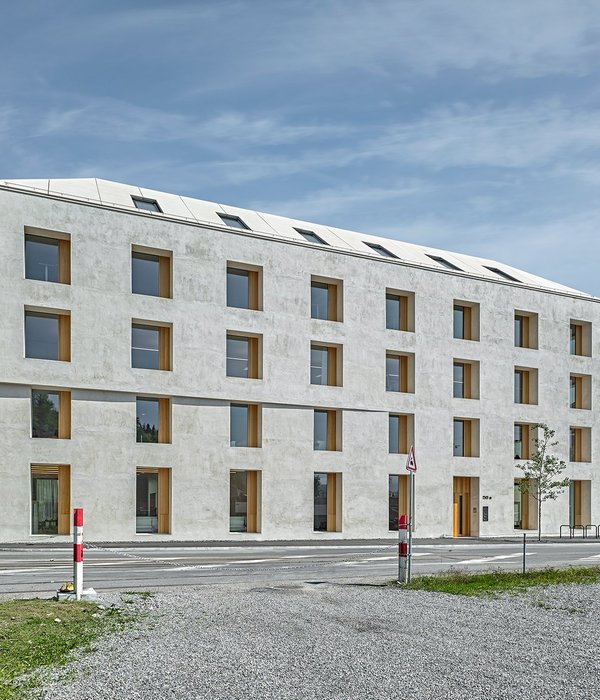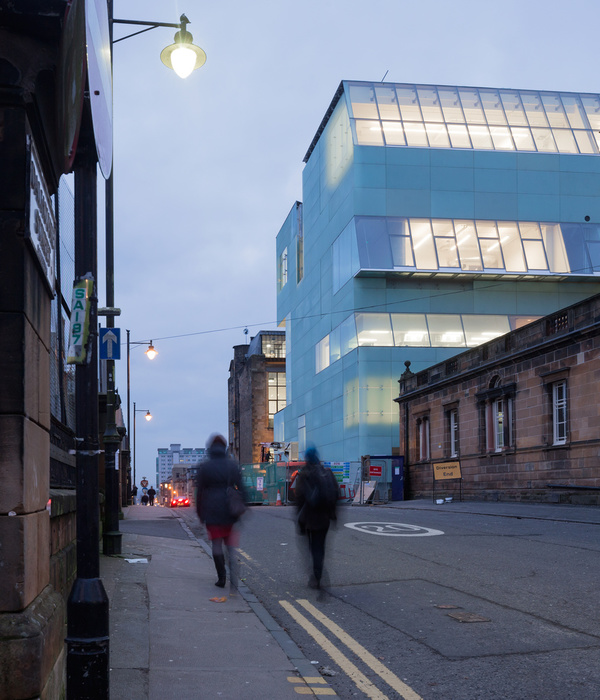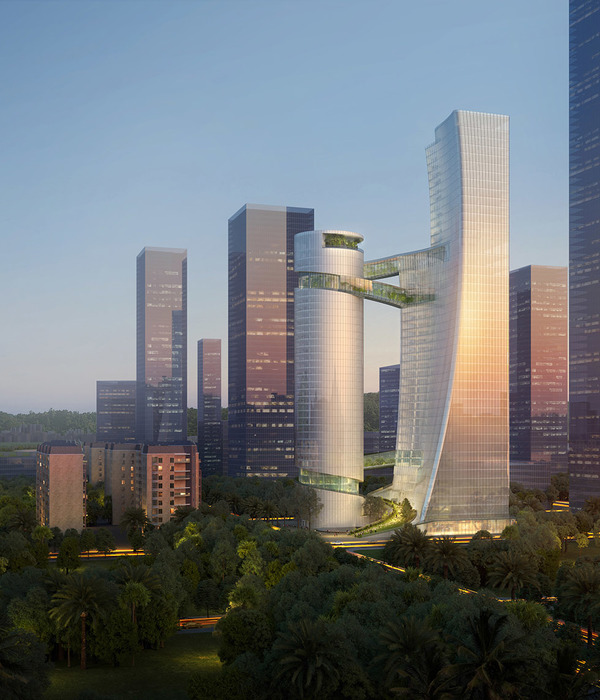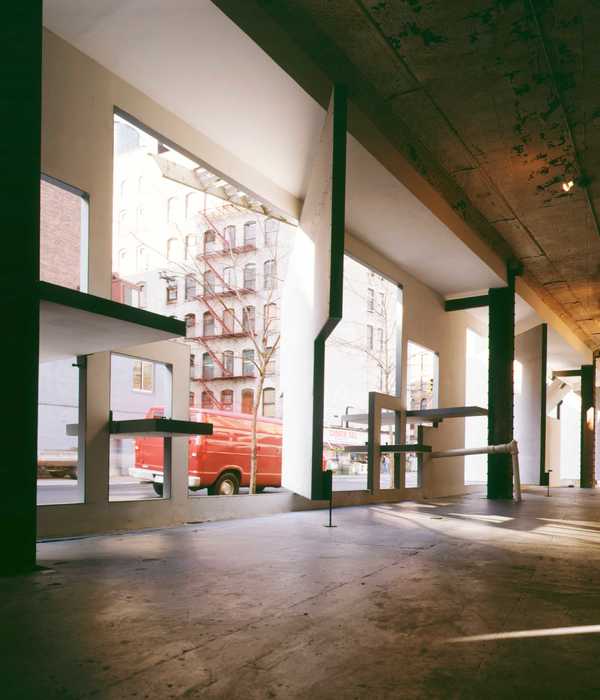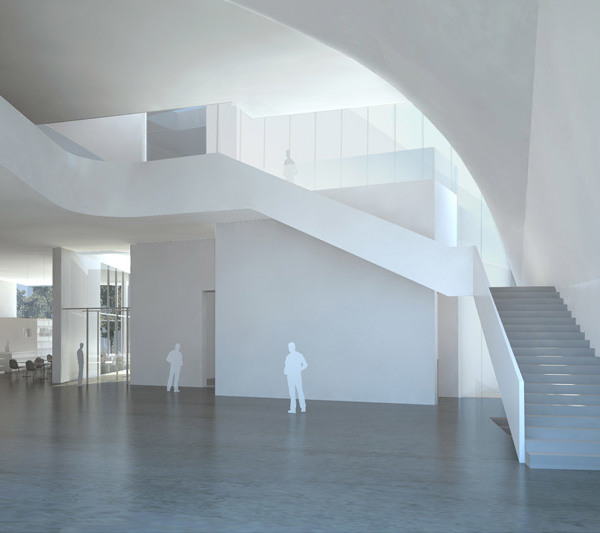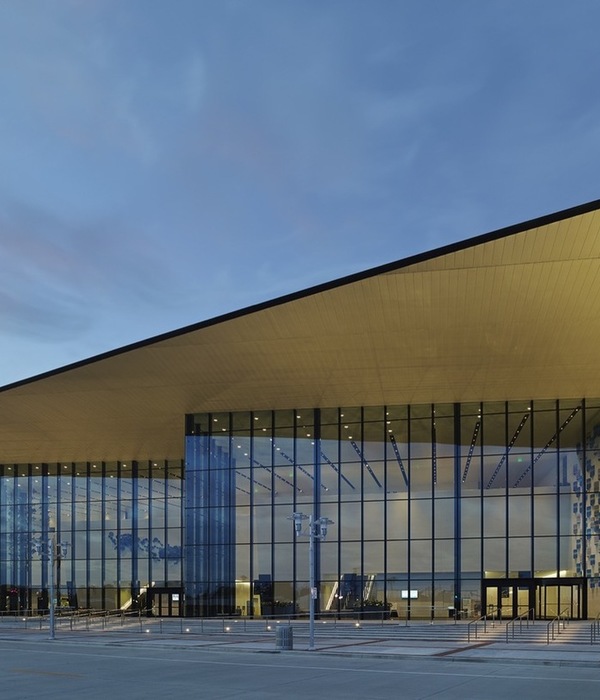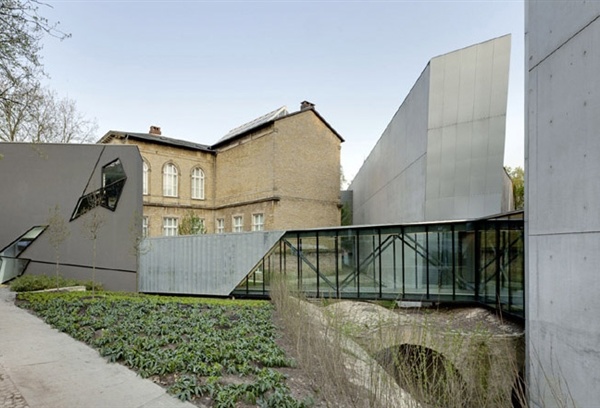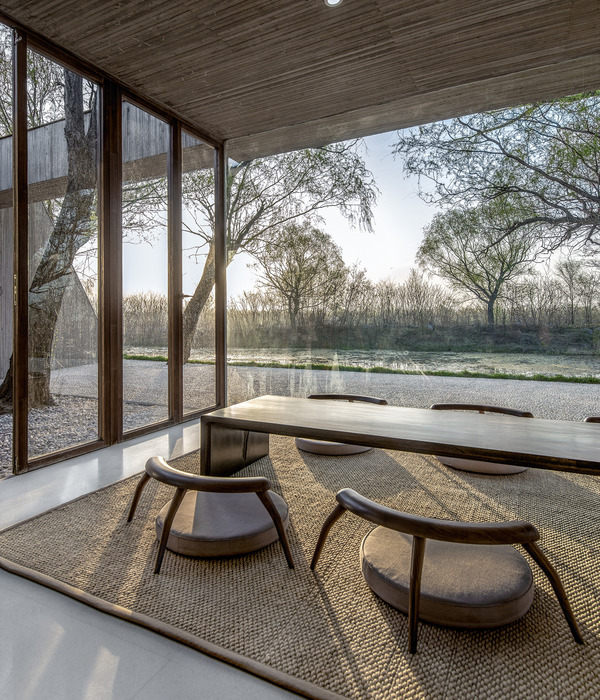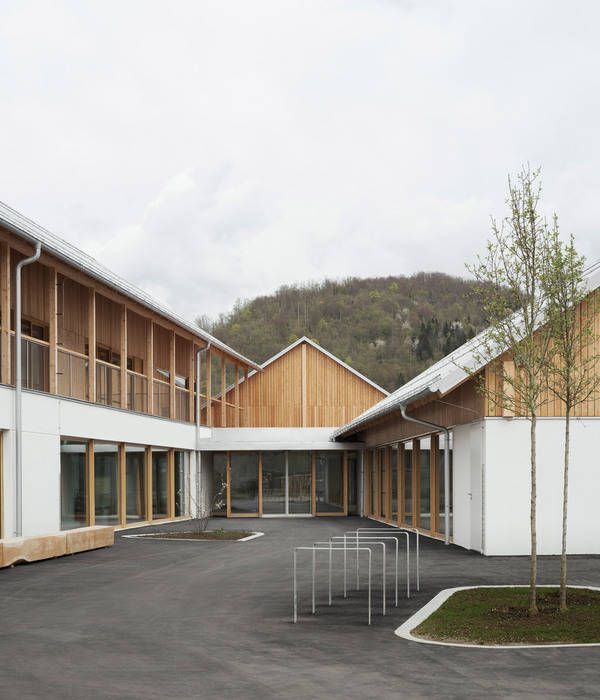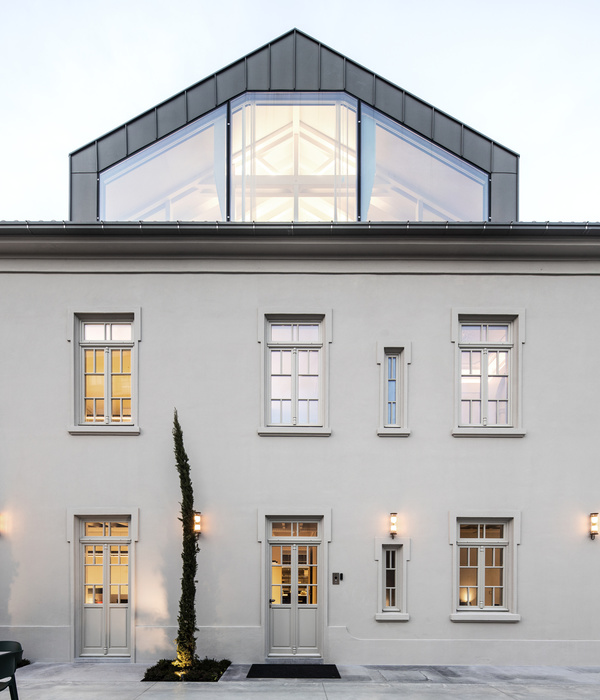华中电厂位于深圳南山区华侨城片区北部。1989年,时值深圳特区经济快速发展,为了缓解华侨城片区“停三开四”电力供应不足的局面,其以重油发电的方式为整个华侨城片区供电。2006年因城市发展及环境保护需要正式“退休”。作为一座见证深圳飞速发展历史的工业遗存点及城市时代印迹,华中电厂记载了许多老华侨城人的生活记忆与集体精神。
▼项目概览,Overall view
The Huazhong Power Plant is located in the northern part of the Overseas Chinese Town area in Nanshan District, Shenzhen. In 1989, during the rapid economic development of the Shenzhen Special Economic Zone, the power supply in the Overseas Chinese Town area faced a shortage, leading to a situation of power supply for three days and blackout for four days. To alleviate this situation, the Huazhong Power Plant provided electricity to the entire Overseas Chinese Town area through heavy oil power generation. In 2006, it was officially retired due to urban development and environmental protection requirements. As an industrial relic and a testament to the rapid development of Shenzhen’s history, the Huazhong Power Plant holds the memories of many old residents of the Overseas Chinese Town and embodies the collective spirit of the era.
▼改造前的电厂鸟瞰图,Aerial view of the power plant before renovation
▼电厂厂房原貌及工业遗存,The original state and industrial heritage of the power plant
华中电厂改造项目和以往改造项目的进程并不相同。在项目接触伊始,园区的景观母题以及色彩基调都已确定。因此,如何在现有基底之上挖掘和再造场所精神,如何平衡场地环境限制与现实功能需求,如何与景观元素相互协调整合始终贯穿在整个改造设计工作中。
The process of the Huazhong Power Plant renovation project differs from previous renovation projects. At the beginning of the project, the theme and color scheme of the park’s landscape had already been determined. Therefore, throughout the entire redesign process, the focus was on how to excavate and recreate the spirit of the place on the existing foundation, how to balance the constraints of the site’s environment with the practical functional requirements, and how to coordinate and integrate with the landscape elements.
▼改造后鸟瞰图,Aerial view after renovation
城市、自然与社区的联结
Connection between City, Nature and Community
项目位于城市、自然与社区界面之间,是整个华侨城片区重要的北门户节点以及社区连接桥梁。基于此项目的历史和未来发展价值,设计将其定义为华侨城片区未来的艺术社区文化引领者,并打造为一处集文化、艺术、社区于一体的城市客厅和创意人文高地,让曾经的片区能量中心重新回归城市,成为社区精神能量之源。从旧电厂到社区场所,为周边居民构建积极的社区公共空间并激活城市片区艺文生态。
The project is located between the interface of the city, nature, and the community, serving as an important northern gateway and a connecting bridge within the entire Overseas Chinese Town area. Based on the historical and future development value of this project, the design defines it as a future cultural leader in the art community of the Overseas Chinese Town area. It aims to create an urban living room and a creative humanistic hub that integrates culture, art, and community, allowing the former energy center to return to the city and become a source of community spirit. From an old power plant to a community space, it aims to construct positive community public spaces for the surrounding residents and activate the artistic and cultural ecosystem of the urban area.
▼区位总图,Site plan
▼北侧鸟瞰图,North aerial view
保留与介入
Retention and Intervention
从场地要素出发,整个地块按南北动静分区。南区是以室外运动、儿童友好以及休闲设施为主的游乐互动体验区。北区则以多功能戏剧、音乐会以及社区文化活动为主的演艺人文创意区域。原电厂拥有五栋独特的工业遗存,但由于各单体边界生硬,布置零乱,无法形成完整的空间故事线。设计以公共空间营造与建筑开放性为出发点,立足于建筑群原有空间布局、体量形制,通过柔化建筑边界,释放底部空间以及透明的玻璃圆场,外挂楼梯,灰空间等建筑手法的介入,在园区创造一种积极生动的“微观城市结构”。
Starting from the site elements, the entire plot is divided into a dynamic and static zone along the north-south axis. The southern zone is a recreational interactive area focused on outdoor sports, child-friendly facilities, and leisure experiences. The northern zone is a performing arts and cultural creative area centered on multifunctional theaters, concerts, and community cultural activities. The original power plant possesses five unique industrial relics, but due to the rigid boundaries and chaotic layout of each building, it fails to form a complete spatial narrative. The design takes public space creation and architectural openness as the starting point, based on the original spatial layout and volume of the building complex. By softening the architectural boundaries, releasing the bottom space, incorporating transparent glass circular areas, external staircases, and gray spaces, it creates a vibrant “micro-urban structure” within the park.
▼改造策略,Renovation strategies
▼香山中街沿街夜景,Night view along Xiangshan Middle Street
O•POWER文化艺术中心(#1)原为发电机组厂房,首层通过置入全玻璃圆场创造新的共享空间,避让保留树木构筑环绕式的沿街公共社区氛围,加强室内外的融合交流与视线通透性。由于原厂房室内光线不足,设计将南立面原有实墙打通,并改造为通透的玻璃及钢格栅,为室内注入更多光线的同时打造成为场所精神的展示窗口。改造后的建筑体量形制与原建筑比例基本一致,并最大程度的保留旧电厂的主体混凝土结构,是对旧电厂的记忆重塑与延续。
The O•POWER Culture and Art Center (#1) was originally a generator plant. The ground floor has been transformed by incorporating a fully glass circular area to create a new shared space. It gracefully accommodates the surrounding trees, creating a community atmosphere along the street and enhancing the integration of indoor and outdoor spaces, as well as providing transparency for sightlines. Due to insufficient natural light inside the original plant, the design opens up the solid wall on the southern facade, replacing it with transparent glass and steel grilles. This allows more natural light to enter the interior and serves as a display window showcasing the spirit of the place. The renovated building maintains a similar volume and proportion to the original structure while preserving the primary concrete structure of the old power plant to the maximum extent. This renovation project is a tribute to the memory of the old power plant while extending its legacy.
▼O·POWER文化艺术中心南立面,O • POWER Culture and Art Center south elevation
▼油罐区看向O·POWER文化艺术中心
Looking towards the culture and art center in the oil tank zone
▼园区入口,Park entrance
▼O·POWER文化艺术中心南立面局部,Partial south elevation
▼首层内缩形成架空公共空间,The first floor shrinks inward to form an elevated public space
▼西立面局部,Partial west elevation
O•POWER文化艺术中心(#1)西侧二层屋面平台原为废弃平台,由于年久失修,设计通过对屋面平台进行修复重塑,并围绕原有烟囱形态植入不锈钢板雨棚形成独特的工业体验场所。保留的工业遗存痕迹和新构筑物形成连续生长的有机体,串联电厂过去,现在和未来,继而使新老构筑物在同一个秩序中进行迭代融合。
The western second-floor rooftop platform of the O•POWER Culture and Art Center (#1) was originally an abandoned platform. Due to years of neglect, the design involves repairing and reshaping the rooftop platform, and incorporating a stainless steel canopy around the existing chimney form to create a unique industrial experiential space. The preserved traces of industrial heritage and the newly constructed elements form a continuous and organic entity, connecting the past, present, and future of the power plant. This allows the old and new structures to iteratively merge within the same order.
▼不锈钢雨棚与工业遗存痕迹-烟囱,Stainless steel canopy and industrial relics traces – chimney
▼碎片化立面状态表达改造建筑的兼容性及真实感,Fragmented facade states express the compatibility and authenticity of the renovated building
同构与共生
Isomorphism and Symbiosis
受到电厂南区遗留的油罐形态启发,以此为母题在主厂房建筑中置入圆筒(O空间)作为新的精神及核心引领空间,与室外油罐展开“对话”。圆筒立面采用UHPC超高强混凝土,减少圆筒壁厚且消解加建构筑物对内部空间的影响。圆筒的植入将原有厂房通高空间划分形成多义使用的O空间与POWER剧场,未来可承载沉浸式演出、艺术展览等多种形态的功能,构建演展融合为核心的前沿剧场集群。
▼ 概念草图,Concept sketch
Inspired by the oil tank forms found in the southern area of the power plant, a cylindrical structure (O space) has been incorporated into the main building as a new spiritual and core guiding space, engaging in a “dialogue” with the outdoor oil tanks. The facade of the cylinder is made of UHPC (Ultra-High-Performance Concrete), reducing the thickness of the cylinder walls and mitigating the impact of additional structures on the interior space. The insertion of the cylindrical structure divides the original high-ceiling space of the plant into the multifunctional O space and the POWER Theater, capable of hosting immersive performances, art exhibitions, and various other functions in the future. This creates a cutting-edge theater cluster centered on the integration of performance and exhibition.
▼ O·POWER文化艺术中心爆炸轴测图,Explosion axonometric diagram
▼O空间,O Space
▼泡沫铝墙面与保留主体结构框架,Foam aluminum wall and reserved main structure frame
▼O空间两旁设置观演台阶
Set up viewing steps on both sides of the O space
▼O空间内部,Inside the O Space
▼光线透过圆筒天窗的斜向杆件投射而成的光影效果,The effect of light and shadow created by the oblique members of the circular skylight
▼二层剧场入口与O空间,Entrance and O space of the second floor
为满足展演空间的绝对纯净与物理性质要求,前厅两侧墙面采用吸音材料-泡沫铝,通过新材料在老墙体的“轻”附着方式,减少对原有结构和老墙体的破坏,同时也增强了圆筒前厅空间的多义使用性。原有的厂房吊车梁以及裸露的原始主体结构使整体空间呈现有趣的新旧碰撞与电厂记忆再现。
To meet the requirements of absolute purity and physical properties for the exhibition space, the walls on both sides of the foyer are covered with sound-absorbing material – foam aluminum. By using this new material with a “light” attachment method on the old walls, it minimizes damage to the original structure and the old walls while enhancing the multifunctionality of the cylindrical foyer space. The presence of the original factory crane beams and exposed primary structural elements creates an intriguing juxtaposition of old and new, providing a vivid representation of the power plant’s memory within the overall space.
▼O•POWER文化艺术中心剖透视,Section perspective
▼多义使用的O空间,Polysemous space
▼多义使用的O空间,Polysemous space
▼吊车梁与裸露的原始主体结构,Crane beams and exposed original main structure
POWER剧场,取自于旧电厂“电力”的核心物理属性,代表着从过去的“物理电力”到如今以演艺内容为核心的“艺术力量”的变迁。剧场为封闭式黑匣子空间,突破了传统镜框式的舞台设计,在剧场内的任意空间都可以成为表演舞台。内设活动伸缩座椅,能容纳约200个座位或约400人站立观演。以自由创新的实验剧场作为内核引擎,联合O空间及户外空间,辐射周边社区乃至城市片区。
The POWER Theater draws inspiration from the core physical attribute of “electricity” in the old power plant, representing the transition from the past’s “physical power” to the present’s “artistic power” centered on performing arts content. The theater is a closed-box space that breaks away from traditional proscenium stage design, allowing any area within the theater to become a performance stage. It is equipped with flexible seating arrangements that can accommodate approximately 200 seats or around 400 standing audience members. Serving as the core engine of free and innovative experimental theater, it collaborates with the O space and outdoor spaces to radiate to the surrounding community and even the urban area.
▼POWER剧场内景(活动座椅展开),POWER Theater Interior
▼座椅收起后,可作为沉浸式音乐会空间,After the seat is folded up, it can serve as an immersive concert space
文创后街(#4)作为城市界面和园区之间的过渡场所,改造前建筑为单一狭长的空间形制,且与北侧侨香路存在3米的高差。为防止小孩攀爬,设计在人行道一侧加设实墙,与新增的不锈钢构筑共同形成檐下灰空间。而后通过植入七个小尺度的水洗石及现浇混凝土盒子,增加原有建筑进深的同时两两盒子通过扭转和错动形成多义灰空间。北侧保留树木与文创后街共同形成有机围合,向内包裹园区,使后街社区与城市形成既开放又融合的空间关系。
As a transitional space between the urban interface and the park, the Cultural and Creative Backstreet (#4) undergoes a transformation from a single, narrow spatial form. There is a 3-meter height difference between the original building and Qiaoxiang Road on the north side. To prevent children from climbing, the design incorporates a solid wall on the sidewalk side, forming an under-eave gray space along with the newly added stainless steel structures. Additionally, seven small-scale water-washed stones and cast-in-place concrete boxes are introduced, increasing the depth of the original building while creating multiple interpretations of gray space through twisting and shifting between paired boxes. The preservation of trees on the north side and the Cultural and Creative Backstreet collectively form an organic enclosure, enveloping the park and creating an open and integrated spatial relationship between the backstreet community and the city.
▼文创后街(#4)局部街景,Street view of #4
折线的坡道将侨香路一侧的人行道路和文化艺术中心(#1)相连,为通向POWER剧场的游客提供了更加便捷的到达方式,同时曲折的坡道造型也为游览者创造在林间漫游,俯瞰园中景色独特视角的场所感。
The zigzag ramp connects the sidewalk on Qiaoxiang Road to the Cultural and Art Center (#1), providing visitors to the POWER Theater with a more convenient access route. The meandering shape of the ramp also creates a sense of place for visitors to wander through the woods and enjoy a unique perspective of the park’s scenery from an elevated vantage point.
▼文创后街(#4)与文化艺术中心(#1)通过坡道相连,#4 is connected to #1 through a ramp
▼后街社区活动,Community activity
▼文创后街(#4)折线坡道,Zigzag ramp
延续与衍变
Continuation and Evolution
#2、#3和#5建筑原分别为电厂油泵房,消防泵房及圆形蓄水池,经更新改造后与“水之塔”(原冷却塔)围合而成酷乐园。
Buildings #2, #3, and #5 were originally the power plant’s oil pump house, fire pump house, and circular water reservoir, respectively. After being renovated and transformed, they now form an enclosure with the “Water Tower” (formerly the cooling tower) to create the Cool Playground.
▼#2、#3和#5轴侧图,Isometric view
▼#2、#3和#5局部鸟瞰图,Partial aerial view
改造后的戏剧酒吧(#2)主体梁柱结构及吊车设备均暴露在外,突显出原有工业遗存的力量和沧桑感,以结构界定来感知原始空间,同时进行适度退让形成室外灰空间,将人流注入“酷乐园”。立面采用“虚”且“新”的水纹气泡玻璃砖以及旧建筑材料-水洗石,展现保留和介入之间相互支撑,相互容纳的关系。
The renovated Theater Bar (#2) features exposed main beam-column structures and crane equipment, showcasing the strength and weathered charm of the original industrial heritage. The structural elements define the perception of the original space, while allowing for a modest retreat to create an outdoor gray space that draws people into the “Cool Playground.” The facade incorporates “hollow” and “modern” water ripple glass bricks, as well as old building materials such as water-washed stones, showcasing a symbiotic relationship between preservation and intervention, where they support and accommodate each other.
▼园区中轴看向戏剧酒吧(#2),View from the central axis of the park towards #2
▼裸露的梁柱结构,Exposed beam column structure
▼戏剧酒吧(#2)与冷却塔,Theater Bar (#2) and Cooling Tower
红砖工坊(#5)位于北区酷乐园的核心位置,原为圆形红砖蓄水池。通过加建一层入口弧墙及外部环形锈钢板楼梯,将一层室内、室外与屋顶重构为有机连续空间,创造独特的场所体验感。外立面采用多孔红色陶砖还原原始建筑形态,以“新“溯源,唤醒场所精神。艺术家工作室(#3)以“光”为设计主线,在原有形体基础上,植入南、北两道斜墙,南侧通过内凹及高侧窗,将光束引入内部的同时保证工作室的隐私性。
The Brick Workshop (#5) is located at the core of the Northern Area Cool Playground and was originally a circular brick water reservoir. By adding a curved entrance wall and an external circular staircase made of rusted steel plates, the ground floor, outdoor area, and roof have been reconfigured into an organic continuous space, creating a unique sense of place experience. The exterior facade uses porous red ceramic bricks to restore the original architectural form, tracing back to the “new” and awakening the spirit of the place. The Artist Studio (#3), designed with “light” as the main theme, incorporates two slanted walls, one on the south and one on the north, into the existing structure. The south side features recesses and tall side windows to bring in beams of light while ensuring the privacy of the studio.
▼红砖工坊(#5)与艺术家工作室(#3)
Red brick workshop (#5) and artist studio (#3)
▼红砖工坊(#5)与艺术家工作室(#3),Red brick workshop (#5) and artist studio (#3)
▼外部环形楼梯与红砖弧墙
External circular staircase and red brick arc wall
▼艺术家工作室(#3)与文创后街(#4),Artist studio (#3) and creative back street (#4)
▼艺术家工作室(#3)局部立面,Artist studio (#3) partial elevation
▼红砖弧墙与木模混凝土细节,Red brick arc wall and wooden formwork concrete details
精神场
Mental Field
从华中电厂到O•POWER文化艺术中心,是一段从“物质电厂”到“精神电场”的改造之旅。通过设计为空间赋形,为场所赋能。我们希望通过旧电厂改造将工业遗存建筑从城市发展的观察者和见证者转化成为积极的参与者和引领者。
From Huazhong Power Plant to O•POWER Culture and Art Center, it has been a transformational journey from a “physical power plant” to a “spiritual electric field. “By designing the space, we empower the place. Through the renovation of the old power plant, we aim to transform industrial heritage buildings from observers and witnesses of urban development into active participants and leaders.
▼周末市集,Weekend market
▼项目模型,Model
▼施工过程记录,Construction process records
▼总平面图,Master plan
▼O·POWER文化艺术中心(#1)首层平面图,1st Floor Plan
▼O·POWER文化艺术中心(#1)二层平面图,2nd Floor Plan
▼O·POWER文化艺术中心(#1)剖面图,Section
▼文创后街(#4)轴测图,Cultural and Creative Backstreet – Isometric drawing
▼艺术家工作室(#3)光影剖面示意图,Artist studio – Sections
▼艺术家工作室(#3)及文创后街(#4)墙身大样图,Artist studio – Wall sections
项目地点:中国广东深圳南山香山东街
Location: Xiangshan East St., Nanshan, Shenzhen, Guangdong, China
业主:华侨城华南投资有限公司
Client: OCT South China Group
建设方:深圳华侨城文化置业投资有限公司
Construction Contractor: Shenzhen OCT Cultural Property Investment Co., Ltd.
建筑设计:深圳华汇设计 X+ STUDIO
Architectural Design: Shenzhen Huahui Design X+ STUDIO
主持建筑师:肖诚
Principal Architect: Xiao Cheng
项目建筑师:麦梓韵
Project Architect: Mai Ziyun
设计团队:傅艺玲,戴佳佳(建筑)丨徐牧,赵婷婷,黎昌发(结构)
Architectural Design Team: Fu Yiling, Dai Jiajia
Structural Design Team: Xu Mu, Zhao Tingting, Li Changfa
景观设计:Lab D+H SH
Landscape Design: Lab D+H SH
室内方案设计:深圳华汇设计 X+ STUDIO
Interior Schematic Design: Shenzhen Huahui Design X+ STUDIO
室内设计深化:文格空间设计(深圳)有限公司
Interior Construction Design: Wenge Space Design (Shenzhen)
结构&机电&施工图设计:深圳宗建建筑设计有限公司
Structural & MEP & Construction Documents Design: Shenzhen ZongJian Architecture Design
建筑及室内泛光设计:北京远瞻照明设计有限公司
Lighting Consultant: zdp (z design & planning)
幕墙设计:深圳市朋格幕墙设计咨询有限公司
Curtain wall Consultant: PAG Facades
建筑及室内标识设计:本质设计
Signage Design: Benzhi Design
结构形式:钢支撑-框架与混凝土框架混合结构体系,框架结构,剪力墙结构
Structure: Hybrid Structure System of Steel Braced Frame and Concrete Frame, Frame Structure, Shear Wall Structure
材料:波纹铝型材,木模混凝土,铝板,弧形玻璃,水洗石,陶砖,雾面不锈钢,UHPC,泡沫铝
Material: Corrugated aluminum profile, Wood Formwork Concrete, Aluminum, Arc glass, Pebbledash, Ceramic Brick, Stainless Steel, UHPC, Aluminum Foam
用地面积:10785m²
Site Area: 10785 m²
建筑面积:3670m²
Floor Area: 3670m²
设计周期:2021.04-2021.11
Design Period: 2021.04-2021.11
建造周期:2021.08-2022.06
Construction Period:2021.08-2022.06
摄影:张超建筑摄影工作室,深圳华汇设计 X+ STUDIO,深圳华侨城创意文化园
Photograph: ZC Architectural Photography Studio, Shenzhen Huahui Design X+ STUDIO, OCT
{{item.text_origin}}


